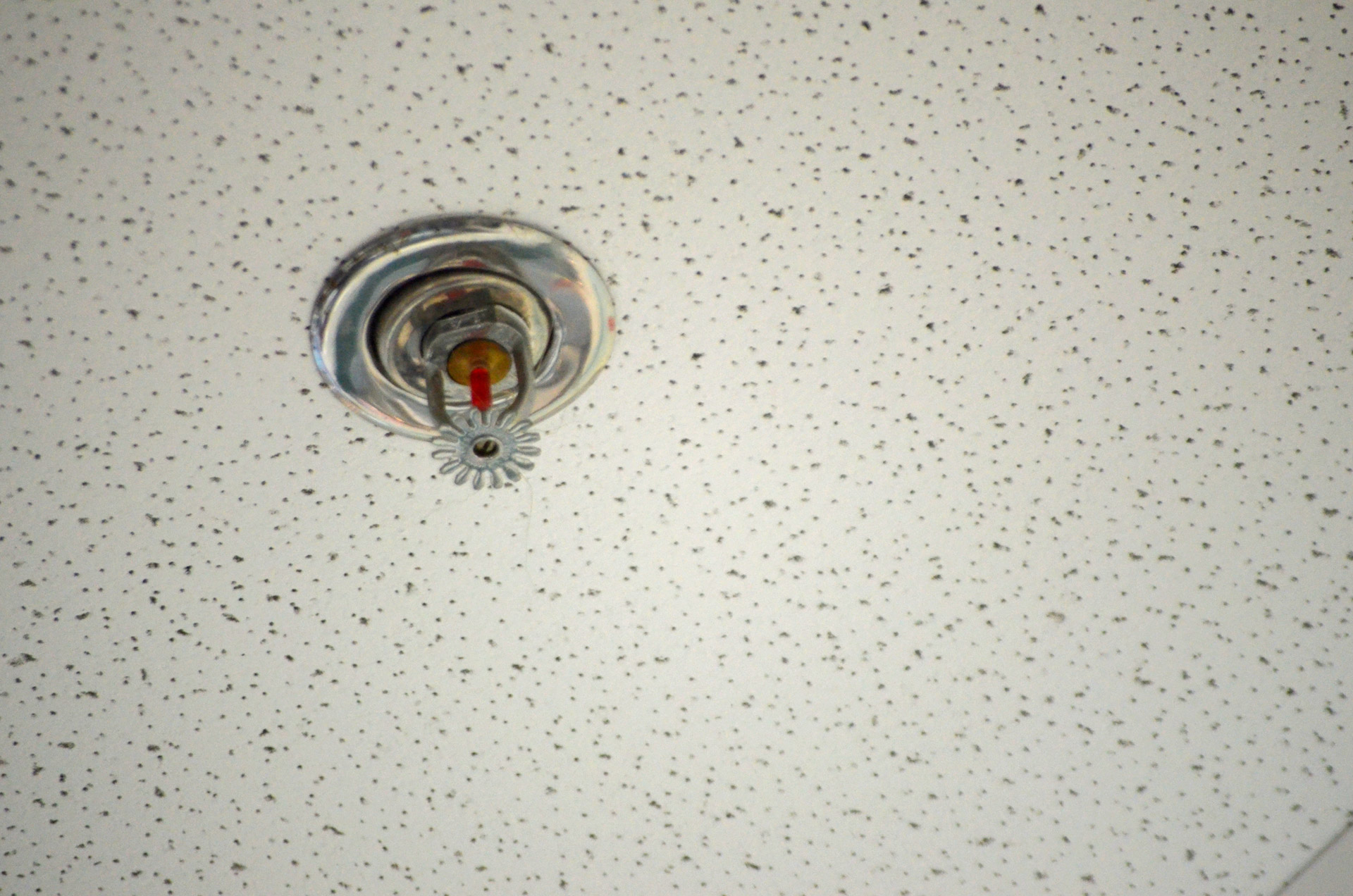Sprinkler head
Contents |
[edit] Introduction
An automatic sprinkler system consists of a water supply (tank, pump and valves) and sprinkler installation (pipes and heads). Almost all buildings over 30m high must be fitted with a sprinkler system installed in accordance with the appropriate British Standards.
The specification of the design depends primarily on the hazard classification of the occupancy of the building. The specifications include head spacing dimensions, assumed area of maximum operation (number of heads in-operation), design density (water discharge), water supply period and tank volume.
[edit] How do sprinkler heads work?
Sprinkler heads are heat sensitive devices that consist of a plug, a glass ampule or other trigger mechanism, deflector, cap and frame.
The system’s heat sensitive element can be constructed from soldered links or glass bulbs containing various liquids. Some sprinkler head ampules contain a mixture of alcohol and water or glycerin and water. When hot air reaches the ceiling, this liquid expands, causing the container to break and activate the sprinkler head so it can distribute water and extinguish the fire.
Sprinkler heads normally activate at 68°C. Each sprinkler head acts as its own heat detector and only those in the area of the fire will be activated. An individual sprinkler head typically covers 9m².
The flow of water from the sprinkler head is generally distributed by a flower-shaped deflector device directly below the sprinkler. This shape is designed to control the flow of the water so it is evenly distributed.
[edit] Sprinkler head variations
There are quick response (QR) fire sprinkler heads which have a smaller ampule so they can activate in a shorter period of time. These devices typically distribute water across the ceiling or down walls as a method of controlling fire by preventing it from rising.
QR sprinkler heads tend to be used in places where many people may be present and life safety is a priority.
Standard response sprinkler heads tend to be used in facilities where there is a greater need to protect the contents of a building.
There are several different sprinkler head orientation options. The most common are:
- Pendant heads use a convex deflector to distribute water in a domed or conical pattern.
- Upright heads spray water upwards to a concave deflector, producing a dome-shaped spray pattern.
- Sidewall heads have a semicircular deflector that produces a crescent-shaped spray pattern.
- Concealed heads are pendant or sidewall sprinkler heads that have been covered with a fire sprinkler cover plate. This cover lowers when a certain temperature has been reached. The fire sprinkler head is then revealed so it is able to activate.
[edit] Related articles on Designing Buildings Wiki
Featured articles and news
Grenfell debarment investigations paused
By request of CPS to safeguard integrity of criminal proceedings. The community reacts.
Delivering for tenants; National Retrofit Hub
New report offers recommendations to strengthen energy efficiency standards to protect private renters.
Government consultations for the summer of 2025
A year of Labour, past and present consultations on the environment, the built environment, training and tax.
CMA competitiveness probe of major housing developers
100 million affordable housing contributions committed with further consultation published.
Homes England supports Greencore Homes
42 new build affordable sustainable homes in Oxfordshire.
Zero carbon social housing: unlocking brownfield potential
Seven ZEDpod strategies for brownfield housing success.
CIOB report; a blueprint for SDGs and the built environment
Pairing the Sustainable Development Goals with projects.
Types, tests, standards and fires relating to external cladding
Brief descriptions with an extensive list of fires for review.
Latest Build UK Building Safety Regime explainer published
Key elements in one short, now updated document.
UKGBC launch the UK Climate Resilience Roadmap
First guidance of its kind on direct climate impacts for the built environment and how it can adapt.
CLC Health, Safety and Wellbeing Strategy 2025
Launched by the Minister for Industry to look at fatalities on site, improving mental health and other issues.
One of the most impressive Victorian architects. Book review.
Common Assessment Standard now with building safety
New CAS update now includes mandatory building safety questions.
RTPI leader to become new CIOB Chief Executive Officer
Dr Victoria Hills MRTPI, FICE to take over after Caroline Gumble’s departure.
Social and affordable housing, a long term plan for delivery
The “Delivering a Decade of Renewal for Social and Affordable Housing” strategy sets out future path.
A change to adoptive architecture
Effects of global weather warming on architectural detailing, material choice and human interaction.
The proposed publicly owned and backed subsidiary of Homes England, to facilitate new homes.
How big is the problem and what can we do to mitigate the effects?
Overheating guidance and tools for building designers
A number of cool guides to help with the heat.
The UK's Modern Industrial Strategy: A 10 year plan
Previous consultation criticism, current key elements and general support with some persisting reservations.
Building Safety Regulator reforms
New roles, new staff and a new fast track service pave the way for a single construction regulator.



























